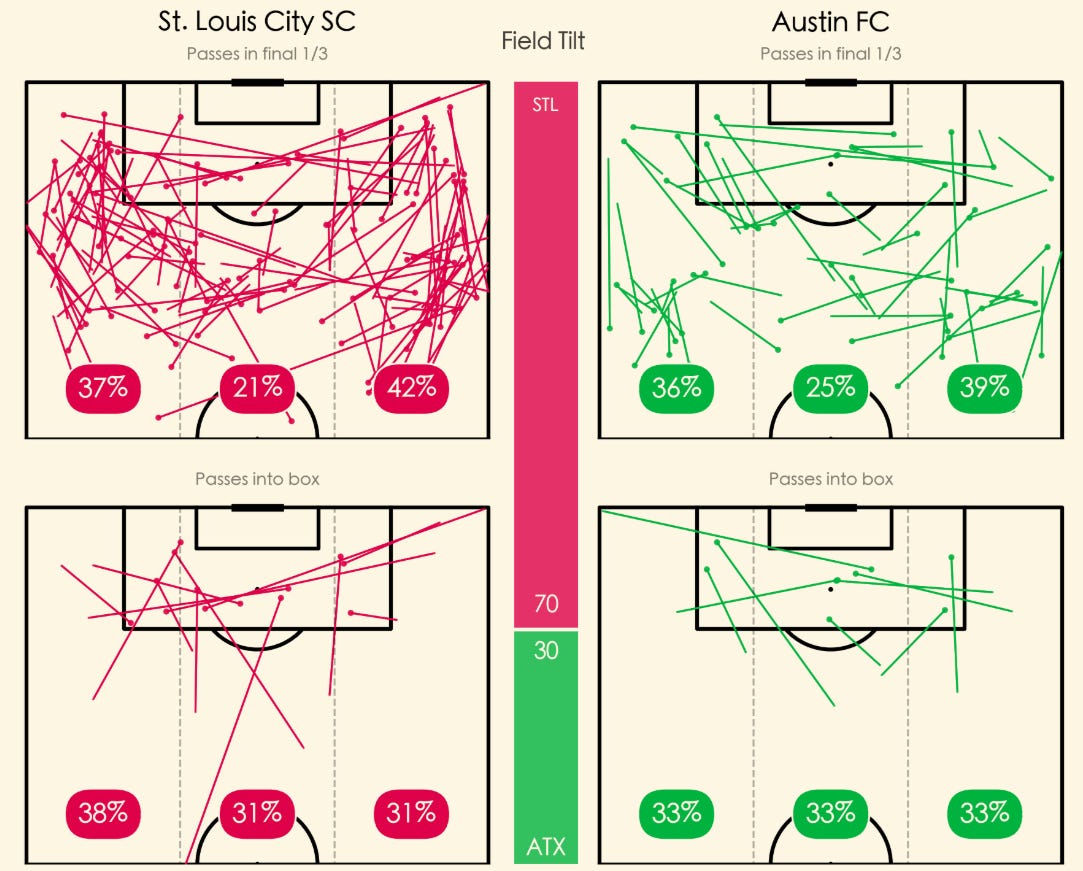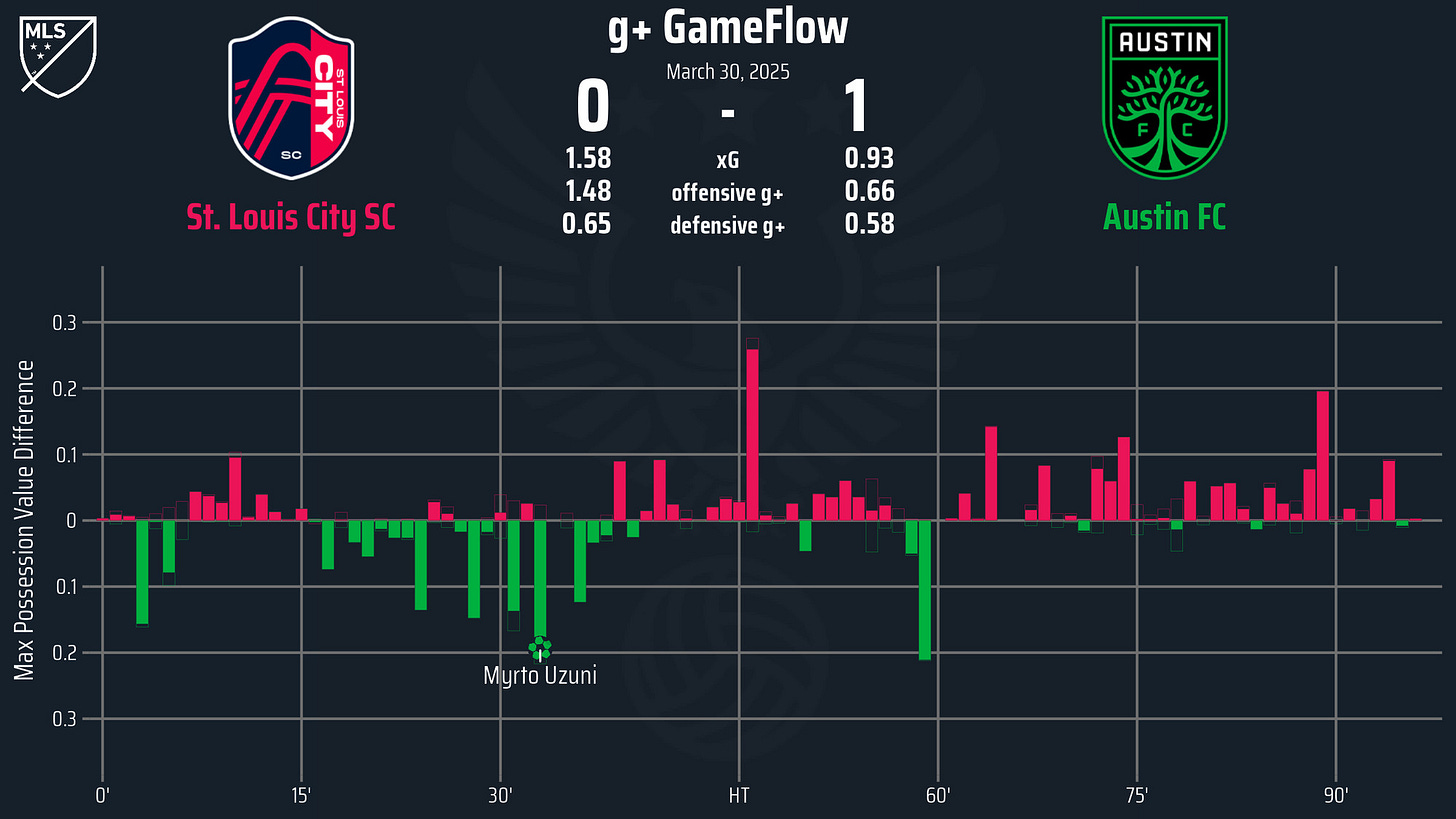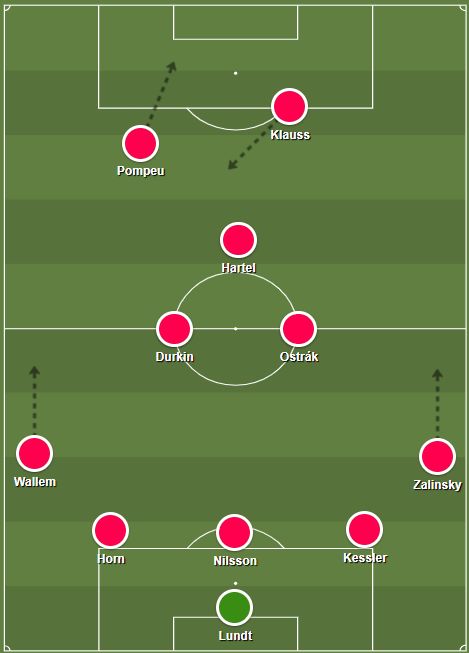How Many Centerbacks Would a Centerback Play if a Centerback Could Play Centerback?
STL 0 - 1 ATX
It’s Monday, it’s Tuesday, whatever; it’s a breakdown after a loss, yay! This is something I should probably revisit, but I wonder if people are more inclined to read in joy or in anger. Today, it will be the latter. So, let’s do our #MLSMondays thing.
STL 0 - 1 ATX.
Team Selection:
Feels like we could spend the whole breakdown talking about this, no?
CITY was without Bürki, Totland, Teuchert, and Löwen on Sunday, and Olof rolled out this XI, which features 8 defensive-minded players and a goalkeeper.
I think people rightly freaked out when Lundt was announced in the net a couple of weeks ago with the Bürki injury, but not enough has been made about the Totland injury. The past two weeks, #AllForCITY has watched some of the worst RB/RWB performances we’ve seen in our history. To put it in terms of the most in-form team in the City, since the Totland injury, CITY is playing on the penalty kill.
RWB
Last week, Watts posted a Per100 passing metric of -15.63 under expected, and Hiebert followed up on Sunday with a -2.90 under expected. On the surface, that hardly seems fair to Kyle, right?
Here’s the issue: ASA has a myriad of passing metrics, including the “Vertical” passing metric, which measures the average distance of passes. Kyle had -1.08 in the attacking third, meaning that, on average, when Kyle received the ball in the attacking third, his average pass was backward by a yard. But that’s not all; Kyle also contributed to 14.3% of all of CITY’s touches in the final third. He attempted 6 crosses (a bigger issue), but only 1 found the target. Jannes Horn, down the left, progressively carried the ball for over twice the distance Hiebert did down the right, and he attempted 0 take-ons.
I like Kyle Hiebert. I believe he embodies everything you’d want in a depth center-back option. He plays within himself, doesn’t shy away from challenges, is always fit, and contributes with those nonquantifiable aspects, along with decent box defending (not in this case, unfortunately). However, let's refer back to that formation graphic. The width comes from one position - wingback. Kyle Hiebert is not well-equipped to provide that. That is not his skill set, just as it wasn't Watts’ skill set the week prior.
This is a fan’s perspective, but I believe I’ve watched enough and learned enough to make an educated guess. Sometimes, coaches cannot see the forest for the trees. They focus on how they want their team to play, how the opposing team tries to play, set pieces, and manage the referees, players, and assistant coaches during the match, among other things. In doing so, I think they can lose sight of some of the most important questions, like “What are we going to do with the ball?”, “How are we going to score?”, or “If this guy gets the ball, what’s next?” This game is like chess. If you aren’t thinking about how this move sets up the next four moves, you’re going to lose unless the other player makes a mistake.
And I think Olof and the coaching staff got lost in the weeds. I think they were overly concerned with the CITY absences and the ATX threat that they forgot to ask the simple questions. Because if they had, I don’t think the answer would be, well, we give it to Kyle out wide, and he makes things happen.
I think they set the team up like that because they believed it was safe, and it would be enough.
If you’ve been reading my stuff for a while, you might remember my criticism of Carnell when we had the ball. I believe, rightly or wrongly, the way to judge a manager’s attacking philosophy is by watching patterns of attacking play, seeing how the team tries to create a scoring opportunity, and then trying to see them do it again, and again. In short, repeatable sequences to consistently generate opportunities. Carnell had none. Olof, so far, seems to have one.
But again, I don’t think they are asking the simple questions:
How are we going to score?
Crosses.
Who is hitting the crosses?
The wingbacks, or the playmakers.
From where?
Out wide, or the half spaces.
Who is going to win that cross and score?
The center forward.
That is repeatable, and CITY sure tried to repeat it. CITY hit 46 crosses on Sunday.
Crossing is NOT my preferred way of generating offense. It is *an* option, but because of their low-percent chance of success (a low percentage pass and a low percentage header), there are better ways to generate offense. At the same time, sometimes, you have to cross it, if nothing else than to keep the defense on their heels.
But, returning to those questions, I have issues with the answers. Hiebert was hitting the crosses. That’s a wrong answer. Who is winning the cross and scoring? The center forwards. That should be plural. If you are playing a style that heavily relies on winning aerial duels in the box, you can’t have Becher going 1v2, 1v3 in the box. You need bodies in the box. Put bodies in the box.
Cross the ball to Becher.
But what if two guys are on him? Who else can we get it to?
(Silence).
We crossed the ball 46 times. We had 1 (one) header register as a shot, by Klauss, in the 86th minute.
Ask the simple questions. Find the simple answers.
Nilsson. Joakim Nilsson posted the fourth highest passing score of STL’s season on Sunday. The combination of Nilsson, Kessler, and Yaro was the most effective center-back lineup we’ve seen, and it helped CITY advance the ball. Ball-playing left-footed centerbacks are rare in MLS. Nilsson is one of them. His issue is that he doesn't have much agility left in his knees, which is why he plays the central center-back role in this formation. If Célio were playing against Nilsson at LCB, I’d expect him to attack relentlessly, running at him and forcing him to move laterally and quickly. Horn is quite good at nullifying attackers running at him in space, which is why he’s good at LCB. Kessler, who can play anywhere, will laughably distribute the ball and gobble space up on defense. Nilsson at center center-back doesn’t get isolated against wingers; he can receive, turn, and distribute the ball as he wishes. He may receive a lot of criticism because he’s a defender, which comes with the responsibility to defend, and although he was outmaneuvered by Bukari on the goal, I’ll leave it to you to decide if a physical mistake is better or worse than the mental lapse that left Uzuni unmarked.
Marcel Hartel has now created the seventh-most shots in MLS, and this total includes two games in which CITY didn’t shoot. On Sunday, how often did Marcel receive the ball in or just outside the box and have to dribble to his right due to a lack of passing options or space? Too many times.
And now, let’s discuss the post-weather second half. I don’t really want to address this, but I think we must. If your takeaway is that Célio, Ostrák, or Klauss needs to play more, I agree. However, beyond that, I advise proceeding with caution. Just as we’ve done this season, Austin was more than willing to sit deep and let CITY attempt to score.
For over 30 minutes, Austin didn’t even attempt to possess the ball. During that time, CITY failed to achieve a possession value of 0.2 or higher, which we’ve been using to gauge dangerous moments all season.
CITY *looked* exciting because Célio was dribbling past players, Ostrák was receiving the ball, turning, and playing it forward, and we were pushing players, even center-backs, forward to score. However, after that period, CITY generated only two shots worth 0.1 xG or better, with the second being Baumgartl’s weak effort in the 90+5 minute.
Did CITY discover a new sense of urgency, a new approach with fresh faces, or did Austin challenge them to do more, and they simply couldn't ? In the coming weeks, we will find out, and I’d certainly like to see something similar to this in Kansas City.
Bogarts > whatever they’ve got out there.
Thanks for reading. #AllForCITY, forever and always.







